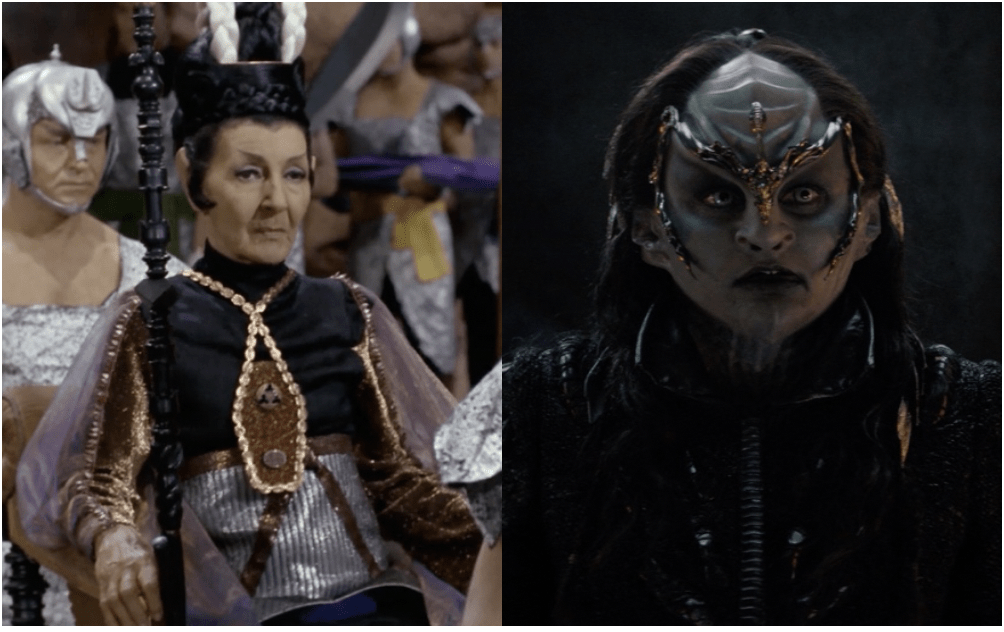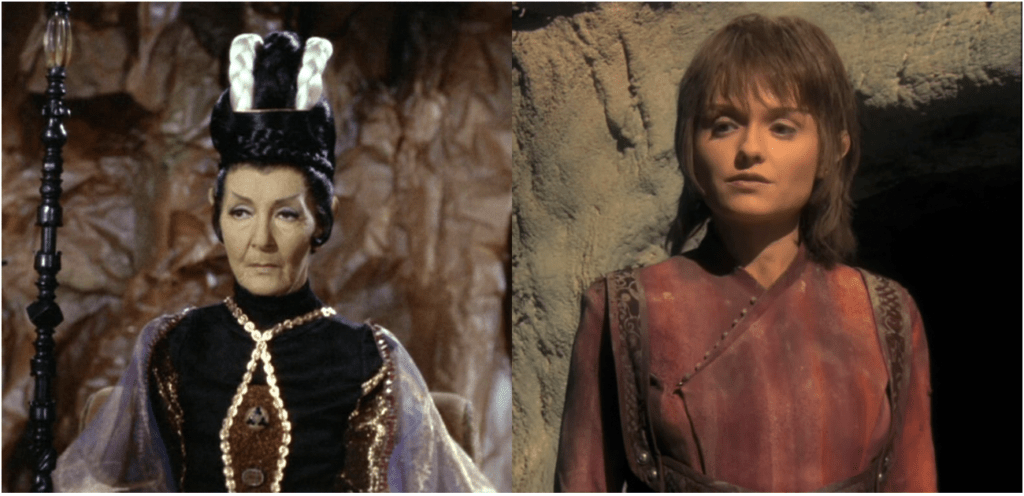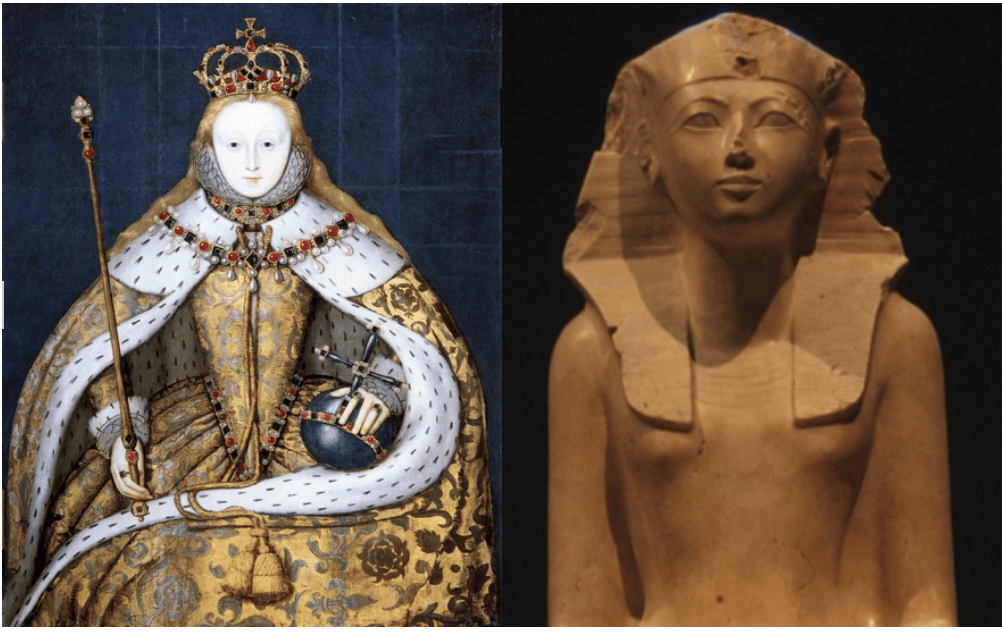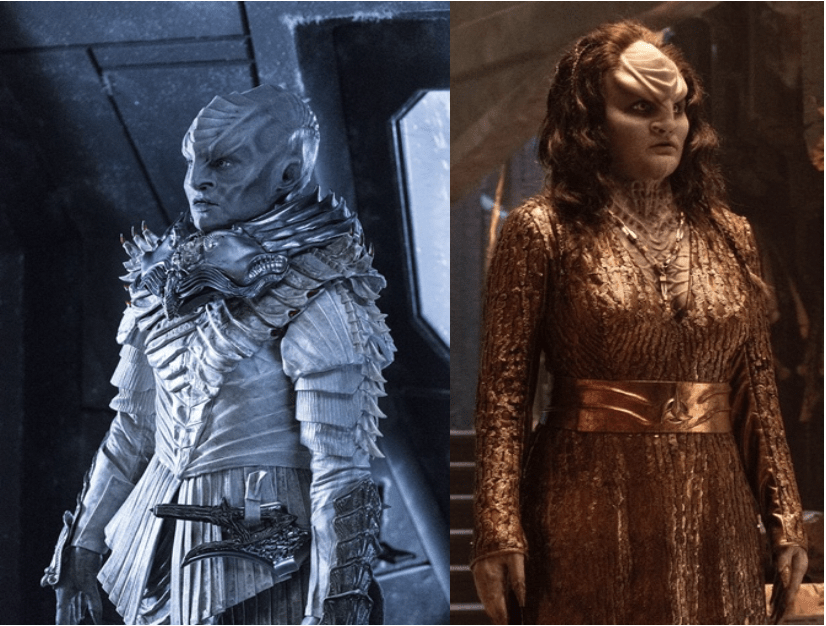
T’Pau making her first appearance in season 2 of Star Trek: The Original Series, played by the talented Celia Lovsky (left), and Chancellor L’Rell portrayed by the incredible Mary Chieffo in Star Trek: Discovery season 2 (right)
Arguably, one of the most important functions of science fiction as a genre is its ability to construct future realities uninhibited by current technological limitations and social inequalities. Madeleine Clark recently published a thought-provoking article on The Mary Sue titled, “Why Captain Janeway Still Feels so Relevant 25 Years After Going Where no Woman has Gone Before.” Clark poses a simple yet poignant answer to her titular inquiry, “there’s something really exciting about seeing women characters for whom gender is never an obstacle to overcome.” Janeway exists in an imagined future where sexism does not exist as it does today, decades after Voyager premiered. This prompted my own reflection on women in positions of authority in Star Trek and to what extent they embody this gender-equal future.
Women at Warp has discussed this subject in depth, especially in episodes focused on Janeway and other women captains in Starfleet. For this blog post however, I examine the representation of women in power within alien societies that are not portrayed as gender-equal in the future, namely T’Pau and L’Rell.
T’Pau of Vulcan

Originally played by Celia Lovsky (pictured left) in TOS, T’Pau is initially presented as a highly revered leader of a planet that values logic above all, but who also reinforces ancient gender roles that seem outdated, particularly from a feminist perspective. Later in Enterprise, Kara Zediker (pictured right) portrays a younger, more rebellious version of the character
Making her first onscreen appearance in The Original Series (TOS) episode “Amok Time,” T’Pau is presented as a prominent political and respected social figure in Vulcan society. Awestruck by her presence, Captain Kirk admiringly relays her accomplishments to Dr. McCoy and states she is the only one to have turned down a seat on the Federation Council. In the episode, Kirk and McCoy witness Spock’s marriage ceremony officiated by the great T’Pau herself. Emphasizing its importance to Vulcan society, T’Pau explains this Vulcan tradition, “comes down from the time of the beginning without change. This is the Vulcan heart. This is the Vulcan soul. This is our way.” During the ceremony, T’Pring, Spock’s intended, invokes her right to initiate the Kaliffee, or ritual combat to the death. T’Pau asks T’Pring first to choose her “champion” to fight Spock, and then inquires if she is ready to become the “property of the victor.” (Icky!) Overall, T’Pau is initially presented as a wise, mysterious authority figure who not only values Vulcan culture and tradition but also is clearly entrusted with protecting it.
In Enterprise, a prequal series to TOS, a younger version of T’Pau leads a minority of Vulcans called Syrrannites, who follow a particular pacifist interpretation of Surak’s teachings. During a three-part story arc in season 4, T’Pau is instrumental in disbanding the corrupt High Command and remains a prominent figure in the ongoing sociopolitical reform on Vulcan afterwards. Evidently T’Pau plays a significant role in shaping the Vulcan society viewers have come to know and love. The only drawback, at least for the feminist in me, is that T’Pau also uses her authority to uphold ancient Vulcan traditions, such as the institution of marriage where women are regarded as property. After taking down a corrupt, seemingly male-dominated government (at least in-universe), T’Pau stays true to Vulcan tradition later when she officiates Spock’s wedding ceremony to continue a practice that has been conducted in this fashion since time immemorial.
Chancellor L’Rell of the Klingon Empire

Chancellor L’Rell declares herself the Mother of All Klingons.
Another example of a powerful women character breaking some gender norms while upholding others is Chancellor L’Rell from Star Trek: Discovery. Mary Cheiffo’s riveting performance as L’Rell illustrates a woman’s rise to power in a role previously dominated by men. During Virtual Trek Con’s “The Influence of Strong Women in Star Trek” panel, Chieffo compares L’Rell to other historical rulers like Queen Elizabeth I and Hatshepsut, who had to navigate a male dominated society. Through insights into Klingon culture provided mainly by The Next Generation and Deep Space Nine, the Klingons clearly have a robust patriarchal society bolstered by values of honor and courage in combat in which primarily men take part. Klingons are arranged into familial units called houses, which the women seemingly run but cannot lead nor can they represent their house on the Klingon High Council. In short, Klingon women have greater social agency in the private sphere while men dominate the public sphere. After viewing a great deal of Star Trek in preparation for her role as L’Rell, Mary Chieffo states that “Their [Klingon women’s] responsibility and their power is in the house, which is a totally respectful thing to be, but that was definitely a key to L’Rell’s character from the get-go she was not that. She was a commander, so she was already an outlier.” From when Discovery viewers first see L’Rell on the bridge of T’Kuvma’s ship, she is already challenging the gender norms of her society. Referring to L’Rell’s self-ascribed role of Mother to the Klingon Empire, Chieffo compares her character’s rise to power to Elizabeth I’s historical ascension to the throne as the Virgin Queen referring to, “the way in which so many women have had to create an archetype for themselves in order for people to listen to them. I find L’Rell’s plot very tragic throughout, but powerful and empowering… but she is so set on upholding her culture.”

Portrait of Queen Elizabeth I, also known as the Virgin Queen, in her coronation robes (left) and statue of Hatshepsut on display at the Metropolitan Museum of Art (right).
Asserting her authority, Chancellor L’Rell gives herself the title of Mother of all Klingons in “Through the Valley of Shadow’s.” Even L’Rell’s costuming reflects this more traditional maternal archetype. L’Rell goes from wearing formidable full-body armor like all the other warriors in the first season, to a floor-length gown in the second season. Chieffo describes how this was intentionally executed behind the scenes,
I did end up being much more “feminized” in the second season… I felt [it] made sense within the plot, within this patriarchal world that as chancellor she had to subscribe to the norms more and that was part of [what] Gersha Phillips,’ our incredible costume designers,’ conceded was that aside from just wanting to give me fun fabulous outfits, the fact that I did have cleavage and there was the notorious Klingon boob-window. All these things that we have seen in the past for how these women have been sexualized in good or bad ways: how is L’Rell trying to grapple with that as a leader? And ultimately within the Madonna/whore dichotomy leaning more towards actually the mother, which kind of falls in between.

L’Rell as an armor-clad commander in T’Kuvma’s house in Discovery season 1(left), and a “feminized” image of her as chancellor in season 2 (right).
While L’Rell’s invocation of the role of “mother” is powerful, it bears further consideration as to why a woman leader must legitimize her authority by framing it within a traditionally feminine role.
T’Pau and L’Rell’s Legacy
From her first appearance in TOS, T’Pau continues to be a respected leader in Vulcan society as her legacy is brought up in other iterations of Star Trek. However, L’Rell’s legacy is unclear. Although Discovery was written more recently, canonically it is apparent from other iterations of Star Trek that the Klingon patriarchy reasserts itself after L’Rell’s reign. Like how Pharaoh Hatshepsut’s successor tried to destroy all records and images of her after her death, Chieffo posits L’Rell’s name does not come up in Klingon history in-universe because her successor wanted to consolidate his power by erasing and/or delegitimizing L’Rell’s rule. Though L’Rell’s rise to power is unprecedented, L’Rell ultimately upholds her cultural heritage as chancellor and seemingly does not challenge the Klingon patriarchy to, for instance, try to elevate the status of other Klingon women during her reign.
Similarly, T’Pau breaks Vulcan norms by being a woman leader who (as far as we know) is not married, and who promotes a great deal of social and political reform by normalizing previously stigmatized practices, like mind melding. T’Pau values her cultural heritage and uses her position and influence to uphold ancient (some could say sexist) Vulcan traditions. Accordingly, T’Pau’s portrayal as an effective revolutionary and competent political reformer gives viewers a strong example of a woman leader who is also a nuanced character, promoting both diversity as well as upholding tradition in Vulcan society.
In comparing these two women characters, it is worth emphasizing that they are alien and therefore represent an “other” for a human audience. Near the end of the Virtual Trek Con panel, Chieffo cautions against judging alien women characters based on our own contemporary human standards. Just as Captain Janeway’s character allows current viewers to imagine a future where gender does not affect women in positions of authority, these alien cultures effectively hold a mirror up to our past and current realities where sexism persists. On one hand perhaps we shouldn’t hold fictional alien cultures to our own standards, but on the other it would be foolish to not remain critical of the structural inequalities illustrated in fiction and how they represent or fail to faithfully depict real people’s lived experiences. As a truly dynamic genre, science fiction allows for both an exploration of future possibilities as well as an invitation to investigate the world as it is now.
I LOVE THIS!